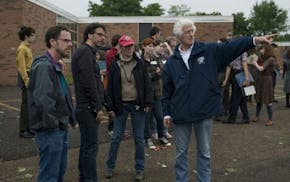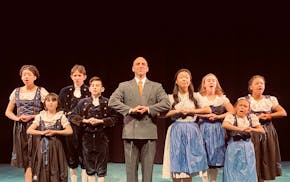He's a visual artist with a big international reputation. A filmmaker. A puppetmaker. An opera director.
William Kentridge wears more creative hats than a Cirque du Soleil clown.
And he racks up air miles like a Hillary Clinton, jetting from his native South Africa to cultural capitals across the globe. When we caught up with him recently, he was in the airport in St. Louis, where he had received a major award and an exhibit of his prints had just opened.
Kentridge said that he was on his way to Jerusalem for a retrospective at the Israel Museum. That exhibit of visual art, film and performance explores migration, colonialism and authoritarianism. It had been at the Museum of Modern Art, where the New York Times found it "enthralling."
"All of my work is about trying to make sense of how we live in the world," Kentridge said. "It springs from my experience, yes, but I'm seeking to understand" the human condition.
Born in Johannesburg, South Africa, in 1955, Kentridge came of age in the crucible of apartheid. His enduring themes were signaled in "Woyzeck on the Highveld," a 1992 work featuring puppetry and film that opens Thursday at Walker Art Center.
While the fall of the Berlin Wall lessened the urgency of much of the work that had grown up in opposition to communism, Kentridge's apartheid-concerned pieces have somehow managed to maintain their currency.
That may be because "Woyzeck" "is less tied to a political system than to a condition that persists" today, he said in the interview. Its longevity -- "Woyzeck" is a favorite at performance arts festivals around the world -- is due to the fact that "it stopped being an allegory about the desperation wrought by apartheid and more about a figure who's even more stuck in his condition. Even if things change for some people, the desperation continues for many."
Classic story
A onetime actor and editorial cartoonist, Kentridge joined up with Capetown-based Handspring Puppet Company two decades ago to adapt this show from the century-old play by 19th-century German dramatist Georg Buchner. "Woyzeck" is the first of several collaborations between Kentridge and Handspring, including "Faustus in Africa," that re-sets Western classics in Africa.
In the original, Woyzeck was a German soldier. But he is a migrant worker in this telling, set in 1956 Johannesburg. A South African everyman, Woyzeck is cuckolded by a miner and used as a guinea pig by a doctor, then wantonly discarded by society.
Kentridge deploys filmmaking techniques in "Woyzeck." He directs viewer attention through the manipulation of hands, mouths and eyes of his puppets, who are sometimes seen thinking and emoting.
"The thing about puppets is that they're lifelike because of a combination of the skill of the manipulators and our willingness as viewers to invest them with life," Kentridge said. "Even though you can see them as wooden objects being manipulated by humans, we can't stop ourselves."
Cinematic riddle
Woyzeck "is resonant because it's fragmented and cinematic," Kentridge continued. "We used short scenes arranged in constructs. But the reason why this work, the original work, has been adapted so often is because great art is about incompletion. It's a riddle you can't solve. It was also extremely radical when it was written, a piece in which working-class people are the heroes, as opposed to the middle-class aristocracy or kings and queens. You don't feel you're watching a period piece but something that speaks very much to the moment."
The show has been on tours around the world. Yet, Kentridge said, he never tires of it. And he hopes Twin Cities audiences will find it just as engaging.
"It's the same puppets with different performers in a world that should be very different as well," he said. "But there are things that have remained constant. And this man's desperation, despite everything, is a constant."
Rohan Preston • 612-673-4390

Meet the Oscar-winning cinematographer who has changed the way the movies look
An Algerian reporter says he was expelled from his country without explanation

A former deli maestro steps into Capt. von Trapp's shoes in Artistry's 'Sound of Music'

NPG vets Michael Bland and Sonny Thompson extend their brotherhood into a post-Prince duo

